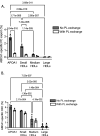This is a preprint.
HDL Particle Concentration and Size Predict Incident Coronary Artery Disease Events in People with Type 1 Diabetes
- PMID: 37986833
- PMCID: PMC10659494
- DOI: 10.1101/2023.11.06.23298165
HDL Particle Concentration and Size Predict Incident Coronary Artery Disease Events in People with Type 1 Diabetes
Update in
-
Sex differences in the associations of HDL particle concentration and cholesterol efflux capacity with incident coronary artery disease in type 1 diabetes: The RETRO HDLc cohort study.J Clin Lipidol. 2024 Mar-Apr;18(2):e218-e229. doi: 10.1016/j.jacl.2024.01.004. Epub 2024 Jan 29. J Clin Lipidol. 2024. PMID: 38320926 Free PMC article.
Abstract
Background: Cholesterol efflux capacity (CEC) negatively correlates with cardiovascular disease risk. Small HDL particles account almost quantitively for CEC, perhaps mediated through efflux of outer leaflet plasma membrane phospholipids by ABCA1. People with type 1 diabetes (T1D) are at increased risk of coronary artery disease (CAD) despite normal levels of HDL-cholesterol (HDL-C). We therefore tested the hypotheses that small HDL particles (HDL-P)-rather than HDL-C levels-predict incident CAD in T1D.
Methods: Incident CAD (CAD death, myocardial infarction, and/or coronary revascularization) was determined in a cohort of 550 participants with childhood-onset T1D. HDL-P was quantified by calibrated ion mobility analysis. CEC and phospholipid efflux were quantified with validated assays.
Results: During a median follow-up of 26 years, 36.5% of the participants developed incident CAD. In multivariable Cox models, levels of HDL-C and apolipoprotein A-I (APOA1) did not predict CAD risk. In contrast, extra-small HDL particle levels strongly and negatively predicted risk (hazard ratio [HR]=0.25, 95% confidence interval [CI]=0.13-0.49). An increased concentration of total HDL particles (T-HDL-P) (HR=0.87, CI=0.82-0.92) and three other HDL sizes were weaker predictors of risk: small HDL (HR=0.80, 0.65-0.98), medium HDL (HR=0.78, CI=0.70-0.87) and large HDL (HR=0.72, CI=0.59-0.89). Although CEC negatively associated with incident CAD, that association disappeared after the model was adjusted for T-HDL-P. Isolated small HDLs strongly promoted ABCA1-dependent efflux of membrane outer leaflet phospholipids.
Conclusions: Low concentrations of T-HDL-P and all four sizes of HDL subpopulations predicted incident CAD independently of HDL-C, APOA1, and other common CVD risk factors. Extra-small HDL was a much stronger predictor of risk than the other HDLs. Our data are consistent with the proposal that small HDLs play a critical role in cardioprotection in T1D, which might be mediated by macrophage plasma membrane outer leaflet phospholipid export and cholesterol efflux by the ABCA1 pathway.
Keywords: calibrated ion mobility analysis; incident cardiovascular disease; prospective cohort study; type 1 diabetes mellitus.
Figures


References
-
- Castelli WP, Garrison RJ, Wilson PW, Abbott RD, Kalousdian S, Kannel WB. Incidence of coronary heart disease and lipoprotein cholesterol levels. The framingham study. JAMA. 1986;256:2835–2838 - PubMed
-
- Dabelea D, Kinney G, Snell-Bergeon JK, Hokanson JE, Eckel RH, Ehrlich J, Garg S, Hamman RF, Rewers M, Coronary Artery Calcification in Type 1 Diabetes S. Effect of type 1 diabetes on the gender difference in coronary artery calcification: A role for insulin resistance? The coronary artery calcification in type 1 diabetes (cacti) study. Diabetes. 2003;52:2833–2839 - PubMed
Publication types
Grants and funding
LinkOut - more resources
Full Text Sources
Miscellaneous
